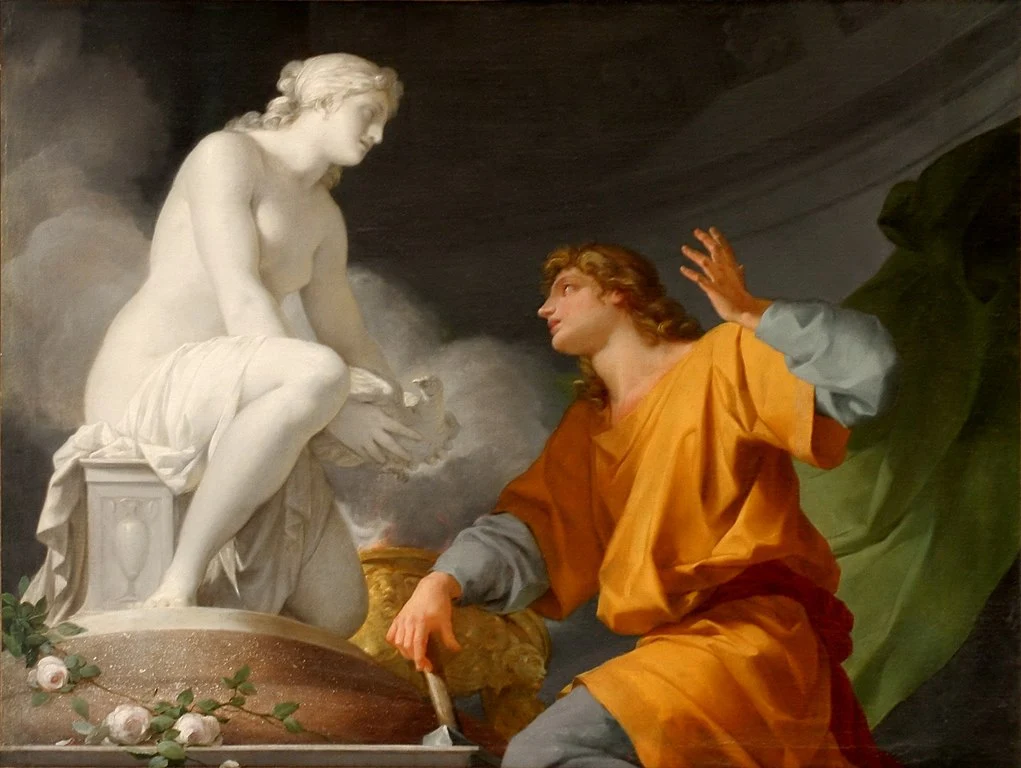The myth of Pygmalion and Galatea stands as one of Greek Mythology’s most renowned tales of love. Pygmalion, a renowned sculptor, finds his heart captured by his own artistic creation, longing to infuse it with life.

This narrative of the story of Pygmalion and Galatea is often interpreted as a portrayal of the masculine desire to exert dominance over a specific woman and to breathe life into the embodiment of his creative visions.
Beyond its core, the myth has wielded significant influence, inspiring theatrical productions, cinematic adaptations, and artistic masterpieces, the most popular of those being a play titled, “Pygmalion” by Irish playwright George Bernard Shaw
Pygmalion The Sculptor
As told in In book 10 of Ovid’s Metamorphoses, Pygmalion was a gifted Greek sculptor from Cyprus. He possessed a remarkable ability to infuse his creations with an uncannily lifelike quality. His profound dedication to his artistic craft left him with little inclination to appreciate the beauty of women. To him, the sculptures he crafted represented the epitome of beauty.
A repulsion to local prostitutes led him to forsake all interest in women and shun their company entirely. Viewing women as imperfect beings, Pygmalion made a solemn commitment to avoid wasting any moment of his life with them. His aversion to women was so intense that he took a solemn vow to never marry.
Pygmalion Builds The Statue of Galatea
Pygmalion’s commitment to his craft led him to fashion the Galatea, an exquisite ivory statue of a woman. Ironically, his magnum opus was a sculpture of a woman, perhaps driven by the desire to rectify perceived flaws in living women.
With unwavering dedication, Pygmalion meticulously shaped Galatea, investing such passion that the statue surpassed the beauty of any woman, living or carved from stone. As he refined the statue’s features, they evolved into a breathtaking loveliness, each stroke of his hammer and chisel infused with deep affection.

When the chisel’s reverberations finally ceased, before him, stood a woman of such gentle and divine grace that his gaze was captivated. Entranced by his own creation, waves of joy and desire washed over him. In a moment of profound inspiration, he christened the figure Galatea, signifying “she who is white like milk.”
Despite his avowed disdain for females, Pygmalion found himself ensnared in deep love. His interactions with the ivory statue became intimate and ardent, a daily routine of gifting, caressing, kissing, and conversation. His offerings mirrored what he thought would appeal to a woman: delicate seashells, beads, melodious songbirds, trinkets, and blooms.
Pygmalion dressed the statue in exquisite attire, adorning her fingers with rings, her neck with necklaces, and her ears with earrings. Yet, how ironic that he who had spurned women should fall for a woman who could never reciprocate his affection!
Pygmalion’s obsession grew, his love for his creation consuming him entirely. The enchantment cast by the lifeless figure proved irresistible, and he longed for her as his wife. Countless were the nights and days he spent transfixed by his own masterpiece.
Pygmalion And Aphrodite
A passion as consuming as Pygmalion’s did not escape the attention of Aphrodite, the goddess of love. Touched by his plight, Aphrodite extended her compassion. During one of Pygmalion’s visits to her temple to offer a bull in sacrifice. In that moment, overtaken by fear of confessing his longing, he silently yearned for a bride who would embody “the living reflection of my ivory maiden.”
Aphrodite bestowed upon him a divine sign. As the flames of his offering blazed in the temple, they soared skyward in a pattern of three consecutive bursts. Baffled by this enigmatic manifestation, Pygmalion returned home, the cryptic omen lingering in his thoughts.
Yet, upon entering his studio, all contemplations vanished in the face of his masterpiece. The statue’s allure captivated him once more, and he rushed to embrace it. There was a faint warmth to the statue’s touch as it had lost its hardness. When he kissed the lips of the statue, Pyhhmalion felt a slight warmth. Aphrodite had woven life into the statue called Galatea.
Gradually, realization dawned upon Pygmalion that the life infused into his artwork was an answer to his fervent prayers to the goddess Aphrodite. Finally, the devotee of Aphrodite managed to articulate his gratitude to the divine entity. With profound humility, Pygmalion prostrated himself at the feet of the goddess.
Pygmalion Weds Galatea
Their love story unfolded over days, their hearts intertwining until wedding vows sealed their union, graced by Aphrodite herself. The goddess showered them with blessings of joy and abundance. Their devotion bore fruit in the form of a son, Paphos, who would lend his name to the city of Paphos in Cyprus, a city consecrated to Aphrodite.
Throughout their lives, Pygmalion and Galatea paid homage to Aphrodite’s temple, and in return, the goddess bestowed upon them a life filled with boundless love and happiness. The extraordinary love that sprouted between Pygmalion and Galatea remains an enduring tale of enchantment. To fall in love with one’s own creation and then to have that creation come alive as a spouse.
Summary
The myth of Pygmalion and Galatea, a well-known tale in Greek Mythology, revolves around Pygmalion, a skilled sculptor from Cyprus who grew disillusioned with human women and dedicated himself to his art. He created the Galatea, a stunning ivory statue of a woman, pouring his heart into every stroke.
Strangely, he fell in love with his creation, lavishing it with gifts and affection. The goddess Aphrodite, moved by his devotion, granted life to Galatea in response to Pygmalion’s prayers. Their union, blessed by Aphrodite, resulted in the birth of a son named Paphos.
This extraordinary love story between Pygmalion and his sculpted creation continues to captivate hearts, resonating across generations as a testament to the power of love and the intricate interplay between art and life.
Also Read: Hades and Persephone: A Tale of Love and Mythical Symbolism
